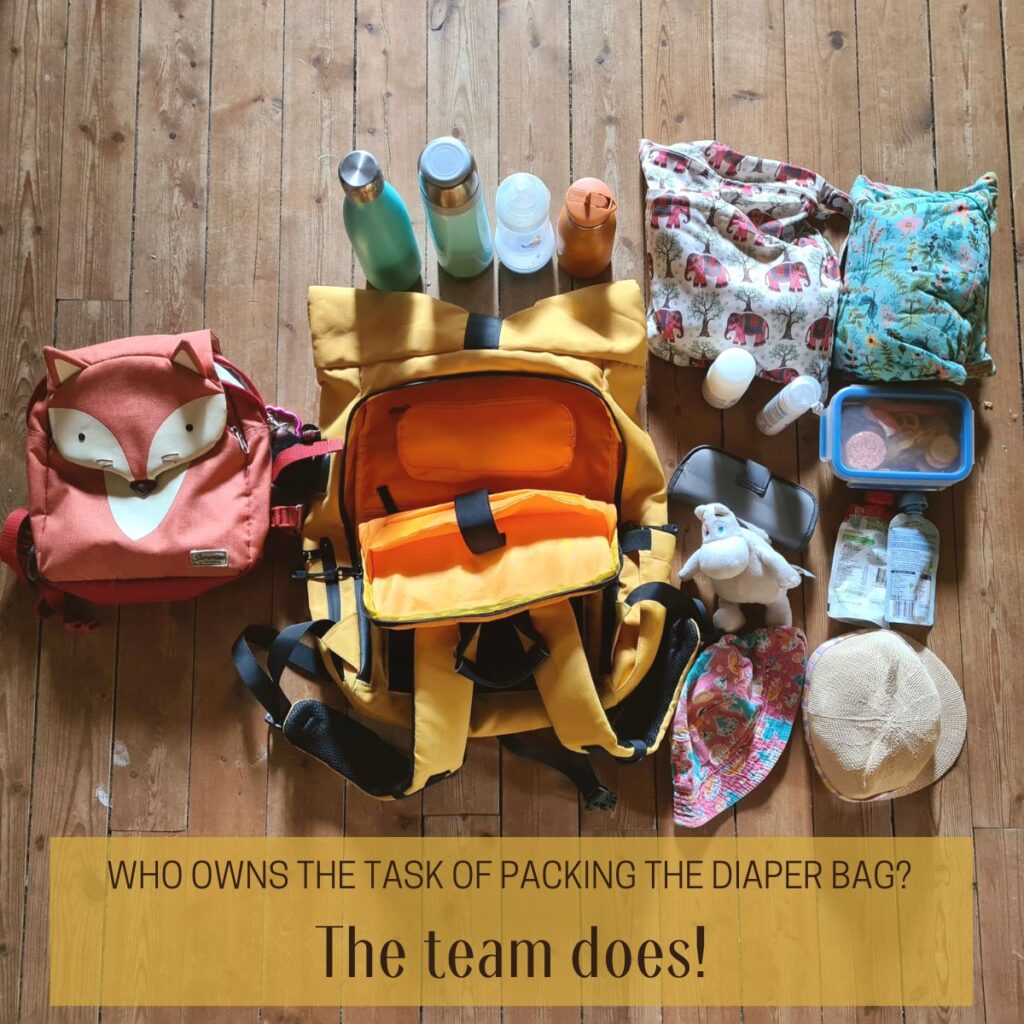
Ever since we had started to discuss having a baby, it was important for us to share the parenting responsibilities, so none of us would become a “default” parent. We pictured that we both would be able to acquire meaningful parenting experiences while maintaining our personal and professional identities. We did explicitly not want that one of us would “manage a small enterprise at home” on top of their professional career, while the other would “help out with the kids”.
What we did not fully realize back then was how much communication, routine decisions and planing the sharing of responsibility requires. One needs to know for instance when a child was last fed, if it slept well, who is going to buy food, if the next playdate is taken care of, if the diaper bag is packed on time for the doctors appointment and if a child’s shoes are getting too small again.
We figured out, that sharing the responsibilities requires tools and heuristics. And while we had no model on how to share the parenting equally, we were able to fall back upon our professional skills. Fortunately, our extended experiences of working in self-organizing agile teams, managing projects, using remote collaboration tools and our agile mindsets in general were a great help.
In an iterative way we figured out several principles and tools to enable sharing. We were able to transform our parenting relationship from the “manager – reportee” model to a self-organizing agile team.
The invisible labor
There is this tendency that when several people are equally responsible for something, no one in particular is responsible.
Often there is one person who takes over a particular responsibility repeatedly and feels like having a bigger burden. And as one person silently takes care of the issue repeatedly, this task tends to become invisible to other people.
Though we were committed to share the responsibilities, we had to learn what it actually involves on the day-to-day level. And we quickly realized that we miss role models of what it means to share parenting equally.
As new parents we unconsciously started to rely on traditional patterns of sharing the responsibility. It took us some deep frustration, loud discussions, lots of negotiations and a feminist book to realize that the invisible work of worry, known as mental load, was the issue.
The mental load
The burden of parenting consists not only of countless diapers and sleepless nights, but of never-ending cognitive labor. The mental load as a term gained popularity after this comic by the french artist Emma was published by the Guardian in 2017.
This invisible labor involved in managing a family typically falls on women’s shoulders. Numerous research has shown how this phenomenon correlates with the well-being and health issues of women and mothers.
Mental load is about being the one in charge. Without wanting it we found ourselves in a typical “you should have asked” situation. I was the one managing the better part of baby related tasks, delegating, scheduling, preparing and checking the progress.
It occupied so much of my brain space that I felt overwhelmed, dissatisfied and less creative in other areas of my life. Putting in the language of evidence-based management, my ability to innovate was low. While my partner was sure he was doing his fair share of childcare, which was true if counted in hours or diapers, he was able to happily throw any responsibility on child’s well-being out of his head once I was around. I was the one to organize and prepare everything even when I was away from the child.
It was not easy to actually communicate what was wrong, until we stumbled upon a book on mental load, which opened up a space for the conversation. We learnt that sharing the mental load is a necessary step to transform the parenting roles from a “manager- reportee” to a self-organizing agile team.
Juggling priorities between parenting and work
Additionally to parenting two children under 3 years old we have two intellectually demanding jobs. There are two loads of professional responsibilities to juggle with the family mental load.
Anyone familiar with agile principles would be horrified with the idea of a team dealing with 3 different backlogs and 3 calendars. It is obviously challenging to figure out the priorities and to keep clear minds.
Furthermore, currently we are sharing our parental leave while working 20h a week each. Interestingly, the load of two part-time jobs and parenting duties does not translate in having one full-time job and a stay-at-home parent. Every parent still has their own professional mental load. There are two sets of appointments, long hours and important deadlines needed to be accommodated in the family schedule and priorities.
Continuous improvement
Having quite a lot of tasks and events to plan weekly, we are trying our best to accommodate all the needs and to keep sane. Though we are mostly able to cope, there are still days when we feel that our heads are exploding. Sometimes there are too many unexpected things happening. And then for instance a request of our wonderful kindergarten to handcraft whatever until Monday next week can become the last straw for a mental meltdown.
We are happy to share our adapted agile practices in the next post, though we are far from wishing to appear as a perfect family who have figured it all out. True to the agile principle we see our experience as a work in progress and a subject of continuous improvement.